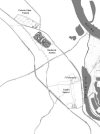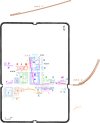
Figure 12: Map showing Xanten, Colonia Ulpia Traiania and Vetera I (drawing P. A. Faulkner)
The double legionary fortress of Vetera I is on the Fürstenberg, c. 1km to the south-east of medieval and modern Xanten in the lower Rhine region, and is a useful site for an analysis of this type (Figure 12). It is predominantly a 1st century CE fortress, and relatively short-lived, lasting from c. 13 BCE until c. 70 CE. It was excavated in the first decades of the 20th century and the finds were comprehensively published in 1995 (Hanel 1995).
Tacitus is the main source for information on the history of the legionary fortress at Vetera I (e.g. Ann.1, 45, 1; Hist. 1, 67.2, 4, 21-23, 36, 57.1, 58; see Hanel 1995, 5-7, 315-25). Like many legionary fortresses in the region, the military base was established here, on the Rhine, during the early reign of the Emperor Augustus, probably in 13 or 9 BCE. In 9 CE, the Roman legions, under the command of Varus, were catastrophically defeated by the Germans, and the great Roman army annihilated. Tiberius, then the governor of the German provinces, called for the retreat and abandonment of the Augustan installations on the Lippe River, on the east side of the Rhine just to the south of Vetera I. Vetera became a refuge for 'dispersed military units, individual soldiers and also women and children ...' from these Lippe Valley sites (Hanel 1995, 322).
In 10 CE, possibly as a consequence of the withdrawal from the Lippe Valley, Vetera became a double legionary camp and thus would have been home to some 12,000 men, and two legates. In 13 CE a mutiny in Lower Germany was led by the garrison at Vetera. Vetera subsequently became a winter camp, probably to the summer camp at Novesium (modern Neuss) between Vetera and Colonia Claudia Ara Agrippinensium (modern Cologne). At this point, Vetera may have been manned by only a skeleton staff or completely abandoned. In 15-16 CE the two Roman legions, the Legio V Alaudae and the Legio XXI Rapax, were stationed here and were occupied with expeditions against tribes to the east of the Rhine.
In 43 CE, under the Emperor Claudius, the Legio XXI Rapax left the Lower Rhine. The Vth legion remained and XX1st legion was replaced by the Legio XV Primigenia. Following the death of Nero, in 68/69 CE, there were a number of revolutionary upheavals in the Lower Rhine, particularly by Batavian mercenaries, and Vetera was besieged and destroyed. After the summer of 70 CE there is no further mention of Vetera by Tacitus so this double legionary fortress was probably abandoned at this time. A successor fortress, Vetera II, was built during the Flavian period but at a different site, on the nearby Bischler Insel. In the 2nd century CE, the Roman colony Colonia Ulpia Traiania (CUT) was founded c. 2 km to the north-east and, subsequently, the medieval town of Xanten. The site of Vetera I was not occupied again.
There had been some investigations at Fürstenberg in the late 19th century, but the fortification walls and the central area of the last fortress here were mainly excavated by Hans Lehner in 1905-1914, and again in 1925-1933/34 together with F. Oelmann (e.g. Lehner 1907; 1912; 1930). These excavations consisted of approximately one-third of the total fortress area of the latest, Claudian-Neronian, fortress. Further documentation and rescue excavation were also carried out at Fürstenberg in the 1960s and 1970s (Hanel 1995, 8-9).
Lehner also excavated outside the walls of the latest fortress at Vetera I and found traces of the fortifications of earlier fortresses (Lehner 1930, pl. II). He published accounts of the process of his excavations, including plans of trenches and buildings. With the exception of a few noteworthy artefacts (e.g. a silvered harness: Jenkins 1985), the artefacts were not published until Norbert Hanel produced a comprehensive catalogue in 1995.
These excavations indicated that Vetera I had at least four building phases (Figure 13). Traces of the earlier fortresses were found to the north and east of the fortification walls, and within the north-central area of the last fortress.

Figure 13: Vetera I, Neronian fort, showing building numbers, kilns and fortifications of earlier forts (by Pat Faulkner)
The earliest wood and earth fortifications ran through the centre of the last fortress, with which were associated some traces of internal buildings. Evidence from related pottery kilns has been used to date this construction prior to 9 CE (Hanel 1995, 287-93).
The next building phase consisted of further wood and earth fortification walls to the north and east of the Claudian-Neronian fortress, commenced between 10-14 CE (Hanel 1995, 294-9).
The Augustan-early Tiberian fortress (Fortress A-C) was burnt down and levelled, either at the end of the 20s and in the 30s CE. It was replaced with a new installation, which was later abandoned and replaced with the final stone-built fortress (Hanel 1995, 300-2).
The Claudian fortress was replaced in the 60s CE, during the reign of the Emperor Nero (Hanel 1995, 307-13). Stone was certainly used for the central buildings, which have been excavated and which are central to this study. This fortress did not last very long, however, and was most probably abandoned during the upheavals after Nero's death.
Through their parallels with other sites and the textual descriptions, and sometimes artefacts found there, Lehner (esp. 1930, 22-68), and others, have identified the functions of many of the buildings as follows:
Lehner (1930, 39) identified the via principalis, running between the east and west gates, as a colonnaded street lined with shops on the north and south sides, more of which were at the east end than the west.
© Internet Archaeology
URL: http://intarch.ac.uk/journal/issue17/4/4.html
Last updated: Mon Apr 4 2005